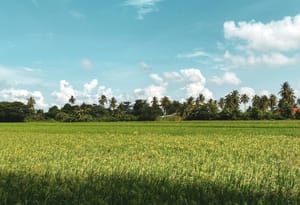GLOBAL RICE PRICE surges highlight the fragility in food security, calling for a diversified and adaptive approach for long-term resilience. Malaysia’s reliance on food imports, including roughly 30% of its rice needs from Vietnam and Thailand, underscores this concern. Rice is deeply embedded in Malaysian food culture, and its supply is now facing challenges from urbanisation, climate change and evolving economic priorities. Therefore, should paddy planting remain central to Malaysian nourishment? Or should alternative food security strategies take precedence?
The Enduring Importance of Paddy
Paddy fields in Penang, particularly in areas like Kepala Batas and Balik Pulau, are more than just agricultural land, they are integral to the state’s cultural identity. Local festivals like the Penang International Paddy Festival in Seberang Perai showcase the deep connection between the community and paddy cultivation. Rice, or nasi, is central to Penang’s famous culinary scene, from Nasi Kandar to traditional dishes like Nasi Lemak—it symbolises the island’s rich agricultural heritage. While the Penang today is known for its industrial development, the remaining paddy fields are seen as a vital link to its past.






